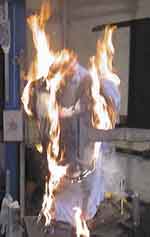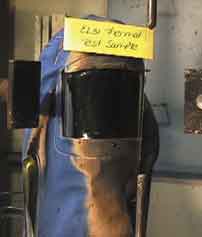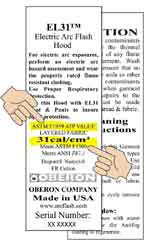Yet, there is another cause, with which many may not be familiar: Arc Flash Explosions.
What is an Arc Flash?
An Arc Flash is the explosive release of energy, caused by the passage of electric current between two electrodes through ionized gases and vapors or an energized source and ground. As employees work on or near energized electrical conductors or circuit parts, an electric arc flash may occur from their inadvertent movement, accidental contact, or equipment failure, causing a phase to ground and/or phase-to-phase fault. The results are quite dramatic. The electrical energy supplied to the arc is converted into a fireball of energy, enveloping the worker. The explosion is made up of intense thermal radiation, noise, explosive expansion of surrounding air due to rapid heating, and melting/vaporization of metal components in the vicinity of the arc. Depending upon the placement of the worker to the arc flash and the severity of the arc flash (based upon amount of energy available to the arc), burns will occur on bare skin and the worker’s non flame retardant clothing will ignite. Workers wearing flame retardant clothing can still sustain burns if the arc releases energy above the thermal rating of the flame retardant fabric (ATPV or EBT). The results can be devastating burn injuries. In many cases, these burn injuries are fatal. Others, result in extended hospital stays, with extended painful treatment. What is often exposed to the arc’s energy is your most public feature, your face. A burn injury to your chest can be hidden by a shirt or jacket, but your face, disfigured by a burn injury, is quite apparent to the world, disrupting your life from that day forward. Every trip to the supermarket or your child’s baseball game. That is how the world will forever see you.

Non-FR Clothing
Tested in Laboratory under Arc Conditions
Photo Oberon Company
Arc Rated Hood meets NFPA 70E
Photo Oberon Company
How do I protect myself?
There are presently several standards in place to provide for a safe workplace. The NFPA (National Fire Prevention Association, NFPA.org) has issued a standard called NFPA 70E-2000, the Standard for Electrical Safety Requirements for Employee Workplaces. NFPA is not an enforcement body, yet OSHA will often refer to this document when evaluating a workplace. This standard calls for the employer to conduct a Hazardous Assessments of work, when voltage exceeds 50 Volts! The worker effectively has two defenses: his knowledge and the PPE he wears. The 70E standard calls for every employee to be properly trained and protected for the work to be performed. Yet, accidents do happen. His last line of defense is the PPE (the clothing and gloves he wears). NFPA 70E calls for the electrical worker to use protection that is suitable for the potential arc energy, to which he will be exposed. Just as the policeman wears a bulletproof vest to provide protection against bullets, so too should the electrical worker use clothing and head protection, tested and rated to the level of the arc flash energy hazard to which he could be exposed.
Arc Flash Protection is much more than FR!
Many companies have a program in place to insure that all employees are wearing Fire Retardant (FR) clothing. Fire Retardant means that the material is designed to self extinguish when exposure to a combustible source (flame) is removed. Non-FR fabrics will burn, once they are ignited, and continue to burn, seriously contributing to the injury of the user. FR garments, on the other hand, are manufactured of fabrics that are either treated to make them fire retardant (like FR treated cotton fabric) or are naturally fire retardant (like Dupont® Nomex®). Presently there are many brands of FR Clothing on the market. In almost every magazine, there will be ads from one of the fabric manufacturers promoting its fabric as the “solution”. It is true that all Arc Flash PPE is FR, but it is important to note that all FR Clothing is not necessarily Arc

Non-Arc Rated Faceshield tested under Arc Conditions
Photo Oberon Company

If the label does have an Arc Rating (ATPV)
it is not Arc Flash protection
Flash PPE. Arc Flash PPE is much more than Fire Retardant! Arc Flash protective garments are designed and tested to insulate the user from the harmful energy, not just self extinguish. What differentiates an Arc Flash garment from a FR garment? The Arc Protective Rating, or ATPV.
NFPA 70E and ASTM F1506 requires that an Arc Flash garment be marked on its label its specific arc protective rating. This will state in black and white the level of the protective characteristic of the product against an arc’s energy. This arc rating is determined by a specific test procedure (ASTM F1959), where an arc flash is created in the laboratories, to simulate real world conditions. Under these conditions, the protective characteristic of the material, from which the garment is made, is determined. Without this arc rating, the garment is simply a work shirt, and should not be used as Arc Flash protection.
I always work de-energized. Why do I need protection?
How does an employee know it is de-energized? To determine if it is in fact de-energized, the employee needs to test for the absence of voltage, using a voltage tester. To conduct this test, he must enter into the prohibited or restricted area. To cross the prohibited approach boundary, the person conducting the work must:
- have specific training
- have a documented plan justifying need for work within the restricted area.
- perform a hazard assessment
- have a work plan and analysis approved by authorized person
- wear PPE rated for the hazard

NFPA 70E Hazard Approach
Once the worker has verified the absence of voltage, they would no longer have the hazard. But suppose he can not work de-energized or there are multiple sources of energy present, in that case he must continue to wear arc rated PPE while he performs his task. Using our previous example of the policeman. A policeman does not always wear a vest, only when he is likely to be exposed to potential harm. So to should the electrical worker wear his protection, when he is in harms way. And just as the policeman does not wear a vest rated for a b-b gun, and expects to be protected from a hail of .57 caliber bullets. So to should the Electrical worker insist that the protection he is wearing be rated to and tested for the level of hazard to which he could be exposed.
How do I compute the level of my hazard?
The NFPA 70E-2000 Standard calls for the employer to conduct a hazard assessment before any work is to be conducted. The purpose of the hazard assessment is to determine the level of hazard present and insure that the electrical worker is trained and protected to the level of hazard present. Presently there are several resources available to assist the employer in conducting his hazard assessment. The Duke Power Heat Flux Calculator is a free DOS shareware program written by Alan Privette to compute the potential arc energy based upon the conditions present. (Available for download at www.arcflash.com). Additionally, there is ArcPro, software developed by Ontario Hydro Testing Laboratory, which costs about $2000 to purchase. For the full service option, if the employer needs additional assistance performing the electrical flash hazard assessment, there are also electrical safety consultants and trainers who are able to come to the facility for a fee and conduct the assessment and put in place training programs.

Work Safe… Be Safe!
Wear only arc rated garments!
We are all heroes… to our families and friends who depend upon us!
While an arc flash explosion does not occur every day within a facility, and with luck, may never occur within one’s professional life, arc flash incidents do occur daily somewhere in North America. While none of us think of ourselves as heroes, to our families and friends who count upon us for love and financial support, we are all heroes. We all have responsibilities. This is dangerous work we perform daily. Each death and severe burn injury, which occurs as a result of an arc flash explosion, is pointless and preventable. If work is conducted by a knowledgeable, trained electrical worker, and he is wearing arc rated arc flash clothing, suitable for
the hazard of the task, every electrical worker can expect to go home safely to his family, with a story of a long day’s work.
The ArcTrainer CD-ROM, covering the Electrical Safety Standards and Arc PPE can be ordered FREE over the Internet at www.arcflash.com/elecCD
Copies of the NFPA 70-2000 Standard can be purchased directly from NFPA at the web site www.nfpa.org/catalog or by phone at 800-344-3555.
Randell B. Hirschmann, Director of Marketing, Oberon Company div Paramount Corp, which has over 60 years experience in Personal Protective products.For more information about Arc Flash PPE, Electrical Safety Standards or available Hazard Assessment resources, please contact Randell
Hirschmann at RHirschmann@oberoncompany.com
or visit the web site at www.arcflash.com







